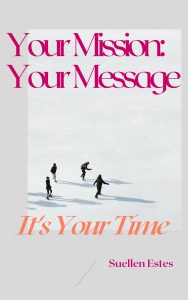
by Suellen | Writing Tips
Let’s be honest. Have you ever noticed that a lot of writing is actually fairly boring?
Yet even if everyone else is creating dry, mediocre content, you don’t have to. You can determine that what you say will be interesting as well as informative.
And one way to do that is to really connect with your audience.
So how do you create this connection between your words and the hearts and souls of your audience?
let me share a couple of tips…
Tell Stories
Stories are good ways to connect with your readers, because a story tends to help you form that emotional connection. It helps the reader identify with you. And a story is much more memorable than simply telling a reader what to do.
You can write this story about you or someone else. Either way, however, the story will be more impactful if the main character is very similar to your readers.
So if your readers are stay at home moms, then you’ll connect to them better if your story is about a stay at home mom who overcame some of the same problems she faces. A story which inspired you.
A story can also help to demonstrate to your readers that you really understand them and their problems. And when a reader feels like the author understands him, you can bet he’ll keep reading.
Create “Reader Oriented” Writing
Your readers have perhaps read plenty of articles, reports and ebooks on the same topic as the one you’re writing about. However, a lot of this content is “author oriented.” That means that it seems to be more about the author rather than the readers
Example: You might read a book about having a good marriage in which the author seems to boast repeatedly about his credentials or delve into personal stories that actually aren’t of interest or relevant to the reader.
One way to quickly check if your writing is author-oriented is to see how many times you’ve used words like “I” or “me” versus how often you use words like “you” and “yours.” You want to use more “you” writing, since this is reader-oriented writing.
Let me give you an example:
- Author-oriented writing: “I’m going to tell you about how I lost weight.”
- Reader-oriented writing: “You’re going to discover a weight-loss trick that’s worked for me – and it will work for you, too.”
Engage the Audience
If you’re writing a “how to” article, then it’s easy to fall into the familiar pattern of writing a straightforward article: “This is step 1… this is step 2…” Basically, it’s the same kind of article everyone else publishes.
Instead, engage your audience by freshening up your writing. This includes:
Adding in your own tips. In particular, include unique tips and tricks not found anywhere
Using stories to illustrate points. Be sure to engage all five of your reader’s senses to really bring him into your story.
Inserting examples to make things more clear. Just look at the way I gave an example of reader versus author-oriented writing above.
Including “spiced up” writing. For example, instead of merely describing someone as nervous, you could say “He was so jittery he could not stay in his chair.”
You’ve painted a picture in their minds which is always more impactful.
In sum…
You’re writing with a purpose, whether it’s to teach your readers something or just to develop a good relationship with them. However, these goals are possible only if your writing engages and connects with your audience.
Use these tips and watch your connections flourish!
H

by Suellen | Write Your Own Book, Writing Tips
Has this ever happened to you?You’re all excited about writing an article, report, or book. You open up a fresh document on your computer. You type in your file name, maybe a title, maybe even a few sentences.
But then it feels like your brain shuts down. Suddenly you find yourself just staring at a nearly blank screen. The words don’t come.
Uh oh, you have writer’s block.
If you do any writing at all, you’ll probably experience writer’s block from time to time.
Here’s how to overcome it…
Of course, prayer is always the first order of business. Relax and ask the Holy Spirit to speak to your heart and remind you of what He wants to say.
Then here are some additional practical tips.
Get Inspired
Sometimes you get stuck simply because you’re tired of looking at the same four walls, the same computer screen, etc. It helps if you can do something to kick start your creativity and give your brain a change of scenery. For example:
- Put on music that inspires you.
- Get out of your usual office and go someplace completely different, like a park or a coffee shop.
- Spend 15-30 minutes doing something different, such as exercising (which will make you feel better).
Copy a Good Piece of Text
This is a way to force your brain to get in the “groove” of writing well. Simply take a passage from one of your favorite authors and start copying it by hand. You can also copy poetry, good sales letters, or anything else that’s well-written.
Naturally, you’re not using this content for anything. You’re just jump starting your own creative process by really thinking about someone else’s well-written piece.
Write Anything That Comes to Mind
Another way to get over writer’s block is to just start writing anything that pops into your head. If you have to write about this week’s grocery list, fine.
If you have to start off writing, “I don’t know what to write” two dozen times across the top of the page, fine. But the point is, just get your fingers moving across the keyboard. After about 20 minutes, your mental “log jam” should be broken up and your creativity released.
Create a Piece About Something Else Entirely
Sometimes it helps to write about something else that isn’t even remotely related to the thing that you need to write about.
So if you need to write an article about Christian Living, you can start by writing an article about how to tie your shoes. Or if you need to create a knowing who you are in Christ, then write a story about how you met your significant other.
Again, this is just a way to loosen up your creativity and get those fingers moving across the keyboard. Once you turn to the piece you do need to write, it will likely go much more smoothly.
Start in the Middle
Have you ever noticed that the introduction is often the hardest part to write? That’s because you use it to give a sneak peek at what the rest of the article, report or ebook is about. But if you haven’t yet written the rest of the content piece, then it’s easy to get stuck on the introduction.
The solution is simple: Start in the middle.
Just skip the intro and go straight to the next paragraph or the first chapter. Then you can do the introduction last, which makes it much easier since now you know exactly what all topics you covered in the rest of the piece.
In sum…
Every writer gets the dreaded writer’s block from time to time. However, don’t let it slow you down.
Next time your brain is moving like molasses, just use the tips above to jump start the creative process!

by Suellen | PLR, Writing Tips
 I love good quality PLR. It’s one of the greatest treasures a writer or blogger can find. When you come across a source of this great quality writing, audios, or videos, you will find your content creation will take on an added dimension.
I love good quality PLR. It’s one of the greatest treasures a writer or blogger can find. When you come across a source of this great quality writing, audios, or videos, you will find your content creation will take on an added dimension.
So What is PLR?
PLR is the acronym for the term Private Label Rights.
The term describes the industry that creates and sells content with permission for people to use as their own. Put simply, the blogger or writer can purchase the material, edit it, and put their name on it. It’s their own material.
The creator of the work sells the rights to use the intellectual material in ways laid out in the terms of the purchase agreement. Most of the time these rights are quite liberal.
Creating content can require lots of time and effort. Thus, salting your creativity with PLR can truly enhance your success.
I use PLR often, but I always edit it to give it my “voice.” Sometimes I almost totally rewrite the work, but I still benefit from the ideas generated by others.
PLR takes many forms. It can be:
- Blog posts
- Emails
- eBooks
- Courses
- And more
Most of the time, the content is written in a general way, sticking to a theme or niche. Then you can use it to target and attract clients and customers. Or in the case of emails and posts, you can use it to provide continuous information for engaging your audience and keeping their interest.
Why should you use it?
When people realize that you are providing great information to help them with their business, they will keep coming back to your website. Or reading your emails.
PLR can be the secret sauce which continues to draw your readers and your customers. Providing ongoing information and solving problems elevates the value you bring to the table. It gives people a reason to come back and not forget about you.
And often you can use the PLR for E-books or Courses which can be sold, adding to your bottom line.
Your goal may be to sell other things or work with people one-on-one and your time is best spent doing activities which make sales or schedule clients. If so, you probably don’t have time to spend creating blog posts, writing emails and newsletters. Or time to come up with new content for the never-ending curiosity of people surfing the net.
Once again, PLR to the rescue. PLR content is just what you need to offer more to your customers. At the same time, targeting their needs and sharing your message.
This ongoing supply of content helps keep you and your goods and services top of mind when people need what you have to offer.
To recap: PLR is pre-written content that you can purchase to use as your own. You can add your branding information and edit the content to best suit your needs.
From start to finish, PLR is an easy way to provide value to your customers and make running your business easier and more profitable.







